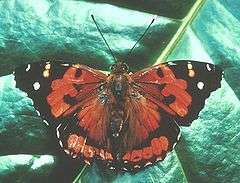Ditrysia
| Ditrysia | |
|---|---|
 | |
| Kamehameha | |
| Scientific classification | |
| Kingdom: | Animalia |
| Phylum: | Arthropoda |
| Class: | Insecta |
| Order: | Lepidoptera |
| Suborder: | Glossata |
| Cohort: | Myoglossata |
| Subcohort: | Neolepidoptera |
| Infraorder: | Heteroneura |
| Division: | Ditrysia Borner, 1925 |
| Principal clades and Superfamilies | |
The Ditrysia are a natural group or clade of insects in the Lepidopteran order containing both butterflies and moths. They are so named because the female has two distinct sexual openings: one for mating, and the other for laying eggs (in contrast to the Monotrysia).
About 98% of described species of Lepidoptera belong to Ditrysia. The group can be divided into the primitive but paraphyletic "micromoths" and the derived monophyletic Apoditrysia, which include mostly larger moths, as well as the butterflies. Those with a dorsal heart vessel belong in section Cossina.[1] Others, having a ventral heart vessel, belong in section Tineina.
See also
References
- ↑ page 657 of Capinera
- Kristensen, N. P. and Skalski, A.W. (1999). Phylogeny and paleontology. Pages 7–25 in: Lepidoptera: Moths and Butterflies. 1. Evolution, Systematics, and Biogeography. Handbook of Zoology Vol. IV, Part 35. N. P. Kristensen, ed. De Gruyter, Berlin and New York.
- Capinera, John, editor (2008), Encyclopedia of Entomology, 2nd ed., Springer Verlag, New York.
External links
- Tree of Life project page: Ditrysia
-
 Data related to Ditrysia at Wikispecies
Data related to Ditrysia at Wikispecies
This article is issued from Wikipedia - version of the 6/7/2016. The text is available under the Creative Commons Attribution/Share Alike but additional terms may apply for the media files.